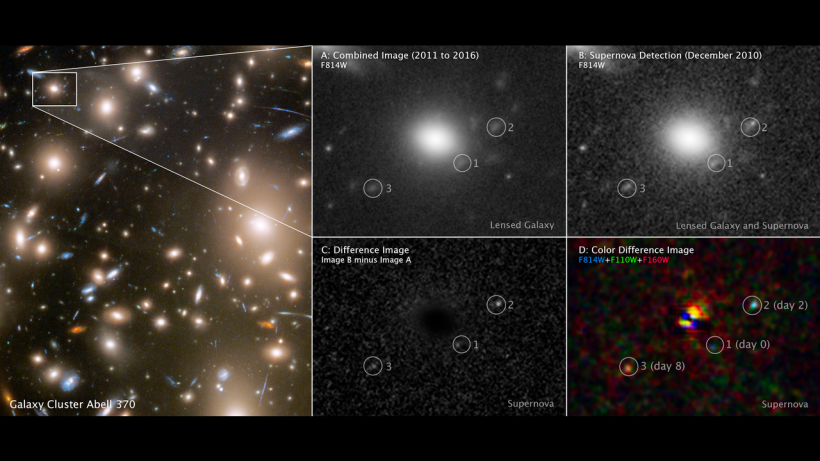NASA's Hubble Space Telescope captured in a single snapshot three different moments of a supernova explosion. The space agency wrote on its website that the star exploded more than 11 billion years ago, which is less than a fifth of the estimated current age of the universe which is 13.8 billion years.
The massive galaxy cluster warped light from the supernova into three reflections, showing different colorful stages of the explosion. Researchers found it while looking into archives of Hubble's observational data from 2010.

Through a phenomenon called gravitational lensing, three different moments in a far-off supernova explosion were captured in a single snapshot by NASA's Hubble Space Telescope. The light from the supernova, which was located behind the galaxy cluster Abell 370, was multiply lensed by the cluster's immense gravity.
Gravitational Lensing Magnified the Light From the Supernova
The image shared by NASA is the first detailed look at a supernova so early in the history of the universe. According to Futurism, the research could help scientists learn more about how stars and galaxies formed in the early universe.
It is also special because it shows the early stages of a stellar explosion. To see a star exploding is extremely rare and researchers were lucky to find it after combing through the archives of Hubble. They identified that the exploding star was lurking behind a galaxy cluster, which makes it the first time that such an event has been observed.
Wenlei Chen, the lead author of the accompanying study, emphasized in the NASA statement how rare it is to detect a supernova at a very early stage since it is usually short. Chen added that this process only lasts for hours to a few days and can easily be missed even for nearby detection. But in the same exposure, Hubble was able to capture a sequence of the images.
NASA explained that it was possible because of the phenomenon called gravitational lensing, which was first predicted by Albert Einstein's theory of general relativity. It can be seen in the photo that the immense gravity of the galaxy cluster Abell 370 acted as a cosmic lens to bend and magnify the light from the distant supernova located behind the galaxy cluster.
Also, the warping produced multiple images of the explosion over different periods that all arrived on Earth at the same time via the Hubble Space Telescope. It was possible only as the magnified images took different routes through the cluster because of the differences in the length of pathways that the supernova light followed and the slowing of time and curvature of space.
READ ALSO: NASA Hubble Space Telescope Finds Star Trying to Revive Companion in Supernova Aftermath
Rapid Change of Color of the Supernova
NASA also noticed that the images captured the fading rapid change of color of the supernova, indicating the temperature change. Blue means it is hot and the earliest phase showed that it appeared in this color. But as it turned redder, it is now cooler.
Assistant Professor Patrick Kelly, the study leader from the University of Minnesota's School of Physics and Astronomy, said that the three images show different colors, representing how it slowly heats up and explode then cool down.
It was also the first time astronomers were able to measure the dying star's size in the early universe based on the brightness and rate of cooling, which depend on the size of the progenitor star. Lastly, the image captured by Hubble indicates that the red supergiant whose supernova NASA scientists discovered was about 500 times bigger than the Sun in the Solar System.
The team's paper titled "Shock cooling of a red-supergiant supernova at redshift 3 in lensed images" was published in the journal Nature on November 10.
RELATED ARTICLE: Discovery Suggests a Supernova Exploded Near Earth 2.5 Million Years Ago
Check out more news and information on Space in Science Times.



![Earth's Quasi-Moon Kamo‘oalewa Could Originate From Lunar Surface Not Asteroid Belt [Study]](https://1721181113.rsc.cdn77.org/data/thumbs/full/53275/89/56/50/40/earths-quasi-moon-kamo-oalewa-could-originate-from-lunar-surface-not-asteroid-belt-study.png)










